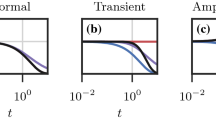Abstract
Subject of this work is the analysis of molecular dynamics (MD) trajectories of neurophysins I (NPI) and II (NPII) and their complexes with the neurophyseal nonapeptide hormones oxytocin (OT) and vasopresssin (VP), respectively, simulated in water. NPs serve in the neurosecretory granules as carrier proteins for the hormones before their release to the blood. The starting data consisted of two pairs of different trajectories for each of the (NPII/VP)2 and (NPI/OT)2 heterotetramers and two more trajectories for the NPII2 and NPI2 homodimers (six trajectories in total). Using essential dynamics which, to our judgement, is equivalent to factor analysis, we found that only about 10 degrees of freedom per trajectory are necessary and sufficient to describe in full the motions relevant for the function of the protein. This is consistent with these motions to explain about 90% of the total variance of the system. These principal degrees of freedom represent slow anharmonic motional modes, clearly pointing at distinguished mobility of the atoms involved in the protein's functionality.
Similar content being viewed by others
References
Land, H., Schultz, G., Schmale, H. and Richter, D., Nature, 295 (1982) 299.
Gainer, H., Russel, J.T. and Loh, Y.P., Neuroendocrinology, 40 (1985) 171.
Breslow, E. and Burman, S., Adv. Enzymol., 63 (1990) 1.
Breslow, E.M.G., In Gross, P., Richter, D. and Robertson, G.L. (Eds), Vasopressin, John Libbey Eurotext, 1993, pp. 143–155.
Kaźzmierkiewicz, R., Czaplewski, C., Lammek, B., Ciarkowski, J. and Lesyng, B., J. Mol. Model, 1 (1995) 135.
Kaźmierkiewicz, R., Czaplewski, C., Lammek, B. and Ciarkowski, J., J. Comput.-Aided Mol. Design, 11 (1997) 9.
Kaźmierkiewicz, R., Czaplewski, C., Lammek, B. and Ciarkowski, J., Quant. Struct.-Act. Relat., 16 (1997) 193.
Amadei, A., Linssen, A.B.M. and Berendsen, H.J.C., Proteins, 17 (1995) 412.
Van Aalten, D.M., Findlay, J.B.C., Amadei, A. and Berendsen, H.J.C., Protein Eng., 8 (1995) 1129.
Lawley, D.N. and Maxwell, A.E., Factor Analysis as a Statistical Method, 2nd ed., Butterworths, London (1971).
Horst, P., Factor Analysis of Data Matrices, Holt, Rinehart and Winston, New York, NY (1965).
Malinowski, E. and Hovery, D.G., Factor Analysis in Chemistry, Wiley, New York, NY (1980).
Saunders, D.R., Psychometrika, 25 (1960) 199.
Murray-Rust, P. and Bland, R., Acta Crystallogr., Sect. C, 34 (1978) 2527.
Murray-Rust, P. and Motherwell, S., Acta Crystallogr., Sect B., 34 (1978) 2534.
Pearlman, D.A., Case, D.A., Caldwell, J.W., Ross, W.S., Cheatham, III, T.E., Ferguson, D.M., Seibel, G.L., Singh, U.C., Weiner, P.K. and Kollman, P.A., AMBER 4.1, University of California, San Francisco, CA.
Breslow, E., Sardana, V., Deeb, R., Barbar, E. and Peyton, D.H., Biochemistry, 34 (1995) 2137.
Author information
Authors and Affiliations
Rights and permissions
About this article
Cite this article
Kaźmierkiewicz, R., Czaplewski, C., Lammek, B. et al. Essential dynamics/factor analysis for the interpretation of molecular dynamics trajectories. J Comput Aided Mol Des 13, 21–33 (1999). https://doi.org/10.1023/A:1008052020514
Issue Date:
DOI: https://doi.org/10.1023/A:1008052020514




